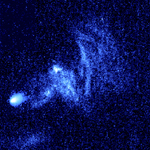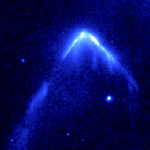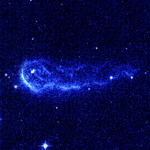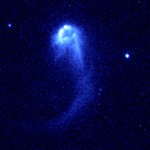 |  |  |  |
| Figure 1 | Figure 2 | Figure 3 | Figure 4 |
Click on individual image for larger viewResembling comets streaking across the sky, these four speedy stars are plowing through regions of dense interstellar gas and creating brilliant arrowhead structures and trailing tails of glowing gas.
These bright arrowheads, or bow shocks, can be seen in these four images taken with NASA's Hubble Space Telescope. The bow shocks form when the stars powerful stellar winds, streams of matter flowing from the stars, slam into surrounding dense gas. The phenomenon is similar to that seen when a speeding boat pushes through water on a lake.
The stars in these images are among 13 runaway stars spotted by Hubbles Advanced Camera for Surveys. The stars appear to be young, just millions of years old. Their ages are based on their colors and the presence of strong stellar winds, a signature of youthful stars.
Depending on their distance from Earth, the bullet-nosed bow shocks could be 100 billion to a trillion miles wide (the equivalent of 17 to 170 solar system diameters, measured out to Neptunes orbit). The bow shocks indicate that the stars are moving fast, more than 180,000 kilometers an hour (more than 112,000 miles an hour) with respect to the dense gas they are plowing through. They are traveling roughly five times faster than typical young stars, relative to their surroundings.
The high-speed stars have traveled far from their birth places. Assuming their youthful phase lasts only a million years and they are moving at roughly 180,000 kilometers an hour, the stars have journeyed 160 light-years.
The Hubble observations were taken between October 2005 and July 2006.

